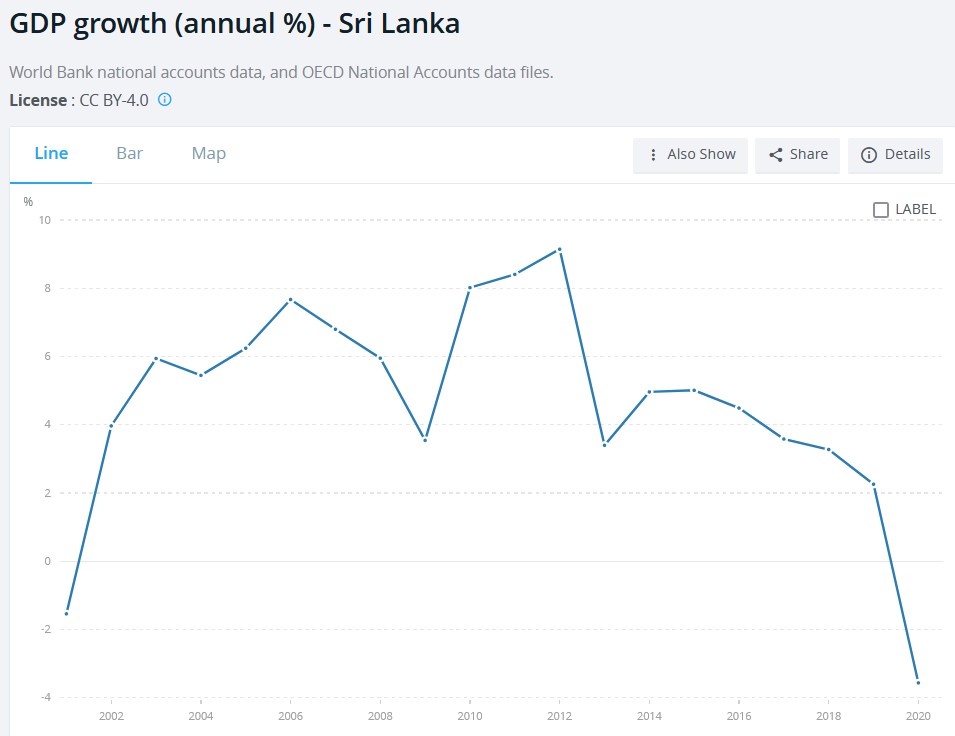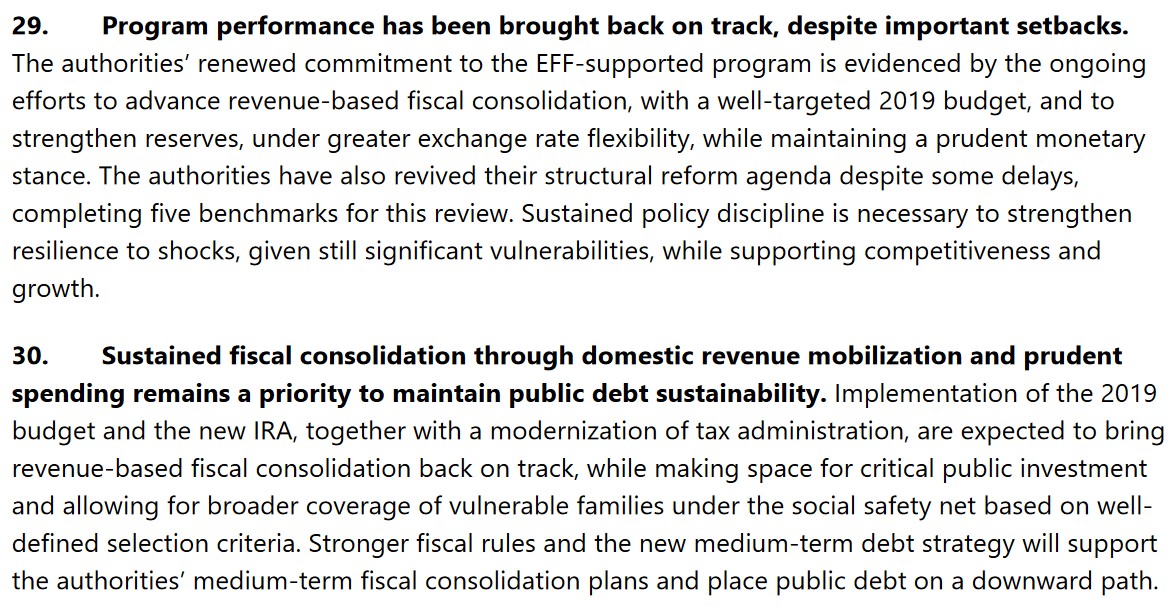
1/ <THREAD> How do we explain and understand the current economic crisis in Sri Lanka? In this thread, I try to follow some of the major events in the nation's economy over the last few years and situate the present crisis in a context.
2/ To begin with, Sri Lanka's economic growth rate was on a decline from around 2012 itself. Its GDP growth rate fell rather steadily after 2012. The post-war growth acceleration petered out soon, and the current account deficit widened in the absence of export growth. 

3/ The economy was stuck with the colonial-era exports of tea and rubber, and garments. The exports of these commodities suffered as global commodity prices fell over the past decade. But two recent events in 2019 ended up imparting a major shock to the Sri Lankan economy.
4/ First, the Easter bomb blasts of 2019 in three churches and three hotels in Colombo, which killed about 253 people, led to a huge fall in the flow of tourists to Sri Lanka. The number of tourists fell by 18%. This led to major strains on the foreign exchange reserves. 

5/ Secondly, the new President Gotabaye Rajapakse, in a thoroughly ill-advised move, cut VAT rates from 15% to 8% in Dec 2019. Also, the "nation building tax" of 2%, and the economic service charge and PAYE tax, were all abolished.
6/ As a result, Sri Lanka had one of the lowest indirect tax rates in the world prior to the pandemic. This led to a major fall in indirect tax revenues. GST/VAT revenues fell from 443,877 LKR million in 2019 to 233,786 LKR million in 2020 i.e., by close to 50%. 

7/ The pandemic hit in March 2020, and it made the bad worse. Tourist inflows and tourism revenues fell further. Exports of tea and rubber declined due to lower demand. Remittances, another booster to the foreign exchange reserves, also fell as Lankans across the globe lost jobs.
8/ With the pandemic, the government was forced to raise budget expenditures. In the context of falling revenues, the fiscal deficit exceeded 10%. In Feb 2022, the IMF identified 3 reasons for this: pre-pandemic tax cuts, weak revenue performance and higher lockdown spending.
9/ This is where the organic farming lobby entered the scene to fish in muddy waters. Home-grown anti-science enthusiasts, and external advisors like Vandana Shiva, advised Rajapakse that the forex pressure could be relieved if Sri Lanka stopped importing fertilisers.
10/ Rajapakse obliged. He posed himself as an organic farming messiah, and banned all chemical fertiliser imports from May 2021. In a blog post in Sept 2021, I had described this in great detail and drawn the contours of its disastrous consequences: bit.ly/3LheruC.
11/ Rajapakse's organic misadventure was supported by many Western environmental groups. Let's call them the "green imperialists" - agents of Western efforts to continue colonising the global carbon budget, and deny the developing world their rightful due in carbon emissions.
12/ Sri Lanka's organic farming policy was a disaster. In most countries, agriculture held up during the pandemic. But it was the opposite in Sri Lanka. According to IMF, there was "worse-than-anticipated impact of the chemical fertilizer ban on agricultural production".
13/ The IMF went on: "the recovery...is expected to be dragged down by a temporary restriction on the use & importation of chemical fertilizer, with an adverse impact on agricultural production, & by the negative effect of...FX shortages & the suspension of certain imports".
14/ So, agricultural production fell; food shortages led to inflation; and food imports became necessary. Production & export of tea & rubber were hurt. Thus, a policy aimed at reducing pressure on forex reserves ended up, perversely, increasing the pressure on forex reserves.
15/ But the IMF's intentions were deeply suspect as usual. In 2016 itself, Sri Lanka had entered into a 36-month extended EFF arrangement with IMF for US$1.5 billion to support an economic reform agenda. The conditionality set by IMF was to reduce fiscal deficit to 3.5% by 2020.
16/ The other IMF conditionalities followed the classic Washington Consensus template: reform of tax policy & administration; control over expenditures; commercialise state enterprises; exchange rate flexibility; boost to competitiveness; and a free investment environment.
17/ After 3 yrs, in 2019, IMF praised SL for its "commitment to the EFF-supported program", "efforts to advance revenue-based fiscal consolidation, with a well-targeted 2019 budget", "strengthen reserves, under greater exchange rate flexibility" and "a prudent monetary stance." 

18/ In reality, the 2016-19 experience with IMF reforms was acutely painful for the Sri Lankan people. GDP growth rates fell. Revenue/GDP ratio fell (btw, corporate tax rate was cut from 28% to 24%). Public debt rose by 30%. And then Rajapakse came in 2019 to wreak serious havoc.
19/ But this was not Sri Lanka's first encounter with IMF. It was the 1st South Asian country to embrace neoliberalism in the 1970s. These IMF-led reforms were accompanied by a suppression of minorities and an onslaught on trade unions and the Left. All this was before the war. 

20/ There is an excellent Himal interview with Ahilan Kadirgamar on Sri Lanks's long tryst with IMF (bit.ly/3qGfwEh). Here, he weaves together narratives on economic crisis and the rightward shift in Sri Lankan politics, aided by conditionality-driven IMF programmes.
21/ Arguing for a radical departure from the past, Kadirgamar laments: "Sri Lankan economists have become lazy, regurgitating the policy prescriptions put forward by the IMF, World Bank...and have lost their capacity to rise up to the challenge to address this historic crisis."
22/ That the IMF template doesn't work anywhere is well-proven, but equally important is the sheer mismanagement of the economy by parties of all persuasions. And Rajapakse's embrace of pseudo-science in agriculture, profusely praised by Narendra Modi, made matters worse.
23/ In all probability, Sri Lanka will now take another new IMF loan with even more stringent conditionalities, and move into yet another deflationary spiral. This, and the rightward shift in internal politics, will only worsen the conditions of people's lives and work.
END.
END.
@threadreaderapp please unroll
• • •
Missing some Tweet in this thread? You can try to
force a refresh



